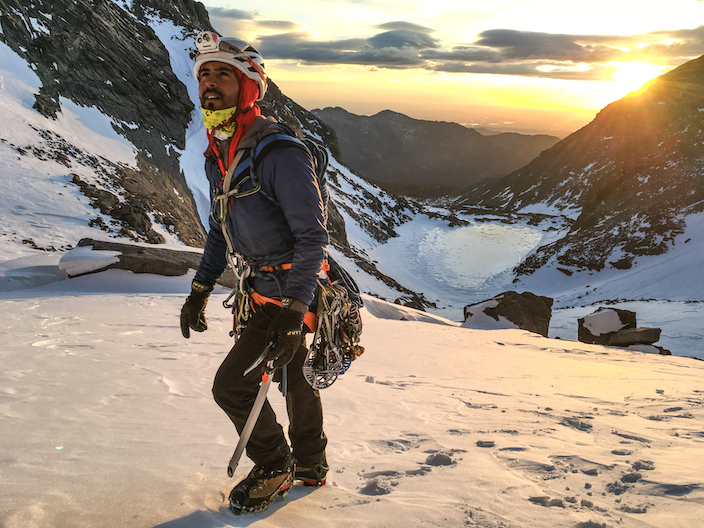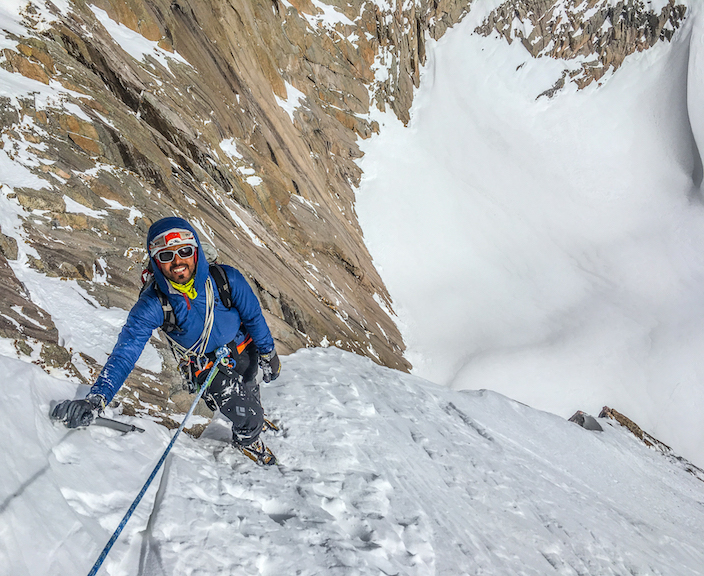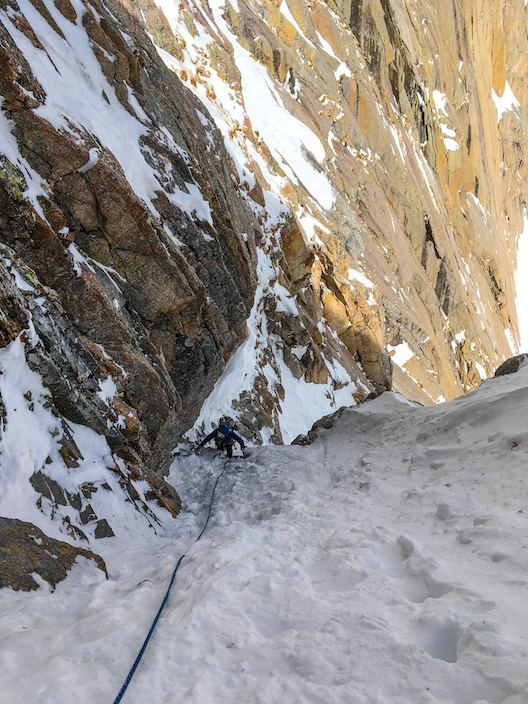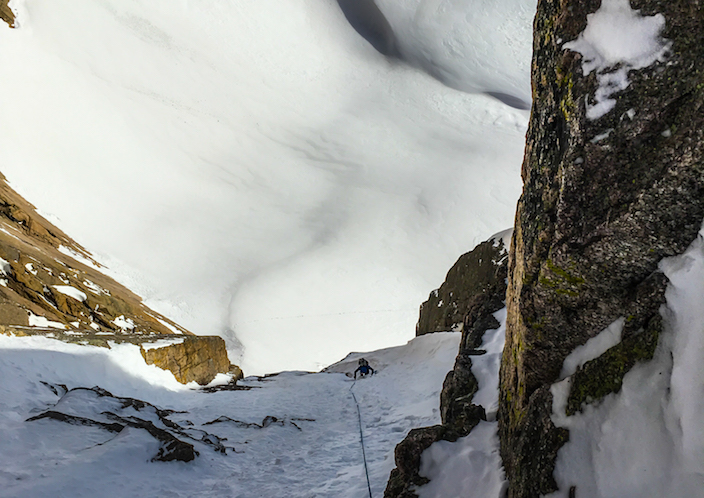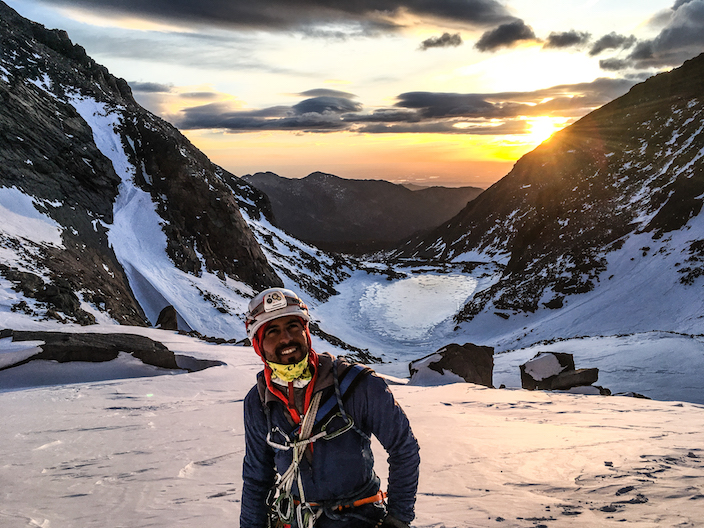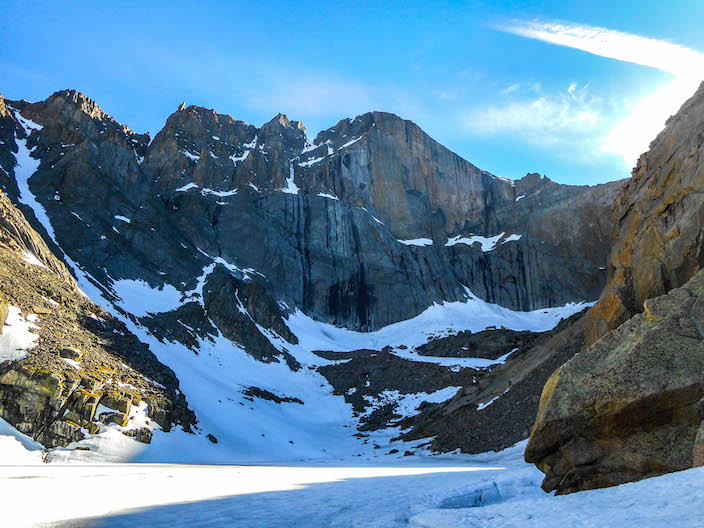Ice Climbing & Winter Mountaineering in Rocky Mountain National Park
Overview
Rocky Mountain National Park (RMNP), straddling the Continental Divide, encompasses hundreds of winter climbs and thousands of skiable acres for any ability level. The high elevation and cold temperatures of the area bring about winter conditions much earlier than other destinations in the US and cause them to linger far into May, providing endless opportunities to hone one’s winter mountaincraft.
A budding alpinist might venture to Hidden Falls to try ice climbing for the very first time, or utilize the falls as a serene training ground for bigger routes. Resort skiers and snowboarders might find the aprons of Hallett Peak or Flattop to be great introductions to backcountry skiing and avalanche awareness.
For more advanced climbers and skiers, the park boasts some of the most dramatic terrain in the lower 48. Climbing routes such as Alexander’s Chimney (III, WI4 M4) or Kiener’s Route on Longs Peak (IV, 5.4 Mod. Snow) offer climbers awe-inspiring views and unparalleled wintry adventures. Experienced skiers also have dozens of spectacular ski descents at their ski tips, such as the must-do Dragontail Couloir, which offers steep skiing in a couloir impossibly splitting an alpine rock tower.
Our winter offerings include our 5-day Winter Mountaineering Course and Private Guided Winter Climbing. With a wealth of experience from our guides, we have the ability to operate in several different locations to adapt to weather and avalanche conditions to ensure the most effective and safest programs. With such diverse terrain, complex snowpack, and variable conditions, the Front Range of Colorado proves to be one of the best teaching venues anywhere.
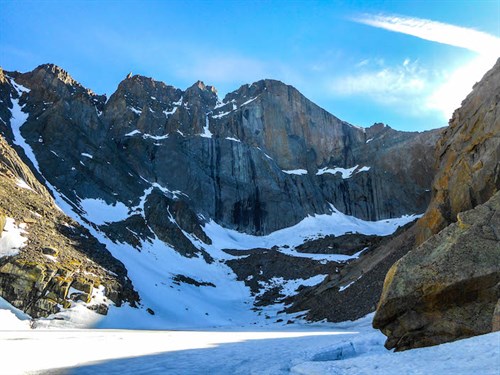
The East Longs Peak Cirque including the Diamond, front and center, in spring conditions. Zach Lovell.
Climbing Season
We offer climbing in Rocky Mountain National Park year-round, with the prime winter ice and mixed alpine climbing season January through February.
Other Winter Courses
Although this course includes an introduction to avalanche safety, winter climbers should consider taking a full avalanche safety curriculum. AAI offers AIARE 1, an Avalanche Rescue Course, AIARE 2, and an Avalanche Pro 1 and 2 Course in Washington during the winter. Please contact the office for further details on our avalanche safety courses.
AAI also offers the Winter Mountaineering Course in Ouray, CO and in the Eastern Sierras, CA.
AAI's Winter Comprehensive Progression
This winter mountaineering course can be combined with our waterfall ice program and our backcountry skiing program. When taken together or pieced together over a season or two, these programs together make up our "winter comprehensive curriculum." Here are links to the other program in this progression:
Save
Ice Climbing & Winter Mountaineering in Rocky Mountain National Park
Ice & Mixed Alpine
Though Rocky Mountain National Park abounds in many types of climbing, the park's peaks are best known for technical alpine rock and ice climbs. Some of the best known climbs are listed here. Each of the routes listed below are available for private guided climbing depending on your previous experience.
Hidden Falls, Wild Basin (I, WI3-4+) Hidden Falls is the classic introduction to ice climbing in the Front Range of Colorado. Located in Wild Basin, RMNP, this area offers several different routes of all difficulties to challenge the budding winter climber in a beautiful setting.
All Mixed Up, Thatchtop (III, WI4) All Mixed Up is one of RMNP’s most classic ice lines. This route is an excellent introduction to multi-pitch ice for climbers who’ve already logged some ice routes and are looking for the next step in their progression for waterfall ice climbing.
Martha, Mount Lady Washington (II, WI2-3, M3) Martha offers climbers an incredible alpine adventure up a prominent couloir on Mount Lady Washington. The route has long stretches of steep snow up to 50 degrees with numerous cruxes where the couloir constricts and challenges climbers with short sections of ice/mixed climbing.
Kiener’s Route, Longs Peak (III, 5.4 Steep Snow, Alpine Ice 2 (AI 2)) The east face of Longs is an awe-inspiring and intimidating sight. The Kiener’s Route finds its way up this imposing face via an incredible yet moderate line.
Starting at Longs Peak Trailhead, climbers hike into Chasm Lake before making their way up the steep snow chute known as “Lamb’s Slide”. From here the world-class quality of this route comes into fruition as the route traverses onto the east face along a narrow ledge known as Broadway. With the Mills Glacier hundreds of feet below, the exposure is dramatic. Finally, climbers make their way towards the summit via the 4th class and low 5th class climbing on the upper east face, along the southern edge of the 1,000-foot vertical wall known as the Diamond. (4 days, minimum)
Without previous alpine climbing experience, climb this as a four-day program with two skills days and two days for the ascent. With previous climbing experience, contact us for further details.
North Face "Cables" Route, Longs Peak (II, AI2, Mixed Grade 3 (M3)) The North Face of Longs Peak, also known as the Cables Route, is one of the best introductions to ice and mixed climbing at altitude. While this route is found by most a moderate summertime climb, the North Face in winter is a completely different challenge. This beautiful face becomes painted with ice and snow to give climbers a world-class adventure normally found in far more remote areas.
North Chimney, Longs Peak (III, M4 Steep Snow) The North Chimney of Longs Peak is an excellent wintertime adventure with steep snow and moderate mixed climbing beneath one of the most famous alpine walls in the country, the Diamond.
Flying Dutchman, Longs Peak Cirque (II, Water Ice 3 (WI3), 5.4) The Flying Dutchman is one of the most popular snow/ice routes in the region with beautiful scenery of the East Longs/Meeker cirque and moderate yet engaging cruxes. This route starts right off the famed Chasm Lake, below the East Face of Longs Peak, and follows a ribbon of white up to the loft of Longs.
Smear of Fear, Longs Peak (III, WI5 M6) Smear of Fear is one of the area's most coveted routes for winter climbers as it provides both a physical and mental challenge. Every fall, locals wait in anticipation for just the right conditions for this fickle line to form.
Alexander’s Chimney, Longs Peak (III, WI4 M4) Alexander’s Chimney is one of the must-do multi-pitch winter climbs in the state. This line typically forms around late October and provides diverse and memorable ice/mixed climbing for roughly four pitches up Longs Peak’s lower east face. Either rappel the route or traverse across Broadway and link with Kiener’s Route for an unbelievable day.
Dreamweaver, Mt. Meeker (III, WI2-3, M2-3) This moderately difficult couloir to the left of Mt. Meeker's Flying Buttress ascends the entire height of the north aspect of the mountain from Mt. Meeker Cirque to the summit. The route comes into shape sometime in the late spring and early summer. The combination of moderate but consistent climbing, direct access to Mt. Meeker's 13,911-ft summit, and a non-technical descent down the Loft Couloir, make this an outstanding adventure.
The Great Dihedral, Hallett Peak (III, M5) The Great Dihedral takes on an entirely different character when climbed in winter. A fantastic and inspiring rope-length dihedral takes climbers up Hallett Peaks imposing North Face. Either descend after the first 350 feet or continue onto another route on the upper buttress (such as the Standard Route or Finch).
Spiral Route, Notchtop (III, Steep Snow, 5.4, M3) Once the Spiral Route (a popular summer route) dons its winter cloak, it becomes a beautiful test piece for the aspiring alpinist. Climbers weave their way around this incredible alpine spire that literally spirals around the mountain via snowy ledges and moderate mixed climbing.
North Face, Notchtop (III, 5.7, WI3) Notchtop’s North Face is many locals’ favorite alpine routes in the winter. Depending on the year, this route is pure ice or can have occasional mixed steps, challenging climbers as they brave their way up this concave alpine wall.
Flattop Mountain, Dragon's Tail Couloir (III, AI2, M2) A popular ski descent in winter months, this couloir turns into an appealing alpine ice and mixed climb in late spring.
Powell Peak, Vanquished (IV, WI5 ,M5) One of the best, high-quality ice and mixed climbs in Glacier Gorge, Vanquished is a hard route that tops out on the summit plateau of Powell Peak (13,208 ft). Five pitches of extraordinarily varied climbing will challenge and delight seasoned alpinists.
